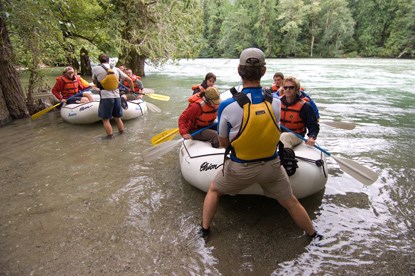In the heart of the forest, a hiker rests on a log stretched across a rushing stream. At water’s edge, a newly emerged dragonfly tests its wings in the chill air. Just below the tumbling surface, young salmon leave their rocky beds to make their way downstream in search of the sea. In a myriad of ways, flowing water is the lifeblood and defining element of the North Cascades.
Major rivers continually shape the landscape on all sides of the Cascade Crest and provide key habitat for thousands of species of plants and animals. Nowhere is this more apparent than in the North Cascades. To the north, the Chilliwack River leaves the park to combine with the Fraser River in British Columbia (the largest watershed along the west coast of North America). The Nooksack River flows west beyond Mount Baker beginning its journey near Mt. Shuksan (the park's most photographed peak). Baker River drains the Picket Range and southeast slopes of Mount Baker joining the Skagit River, which flows from Canada, then westward across the middle of North Cascades National Park Complex. The Skagit is the largest watershed emptying into Puget Sound. In spite of the three dams along its length, the Skagit supports all five species of Pacific salmon and two anadromous (or sea-going) trout. The Stehekin River drains the southeast corner of the park to feed Lake Chelan – a glacier-carved trough which at 1500 feet is the third deepest natural lake in the nation. The waters of Lake Chelan eventually make their way to the mighty Columbia River, the largest river system in the western US.
These large rivers are fed by hundreds of streams with their origins in the steep mountains and glaciers. Late each summer these streams carry finely ground rock particles, or glacial flour, that cloud the water and lend a characteristic color. Local nicknames for the Skagit River include the Emerald Skagit and the Magic Skagit. The most dramatic contribution to this phenomenon is from Thunder Creek, which drains over fifty glaciers before flowing into the turquoise reflecting waters of Diablo Lake reservoir.
For the early peoples of this region the rivers were home, serving as means of transport, a key source of food, and clean drinking water. This still holds true today, and for the modern visitor the flowing waters of the North Cascades provide additional values of recreation, education, inspiration and hydropower.

